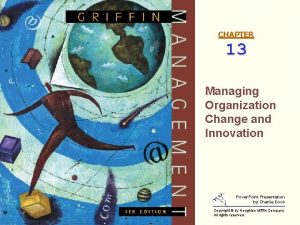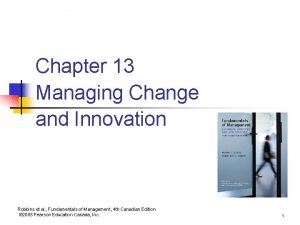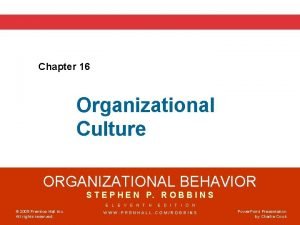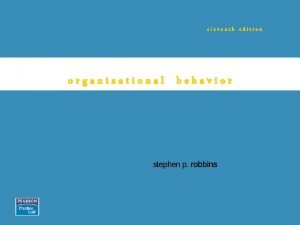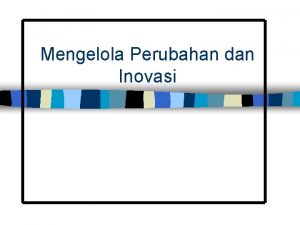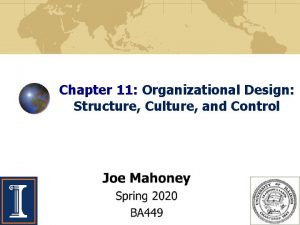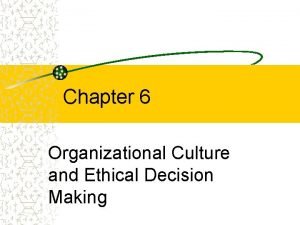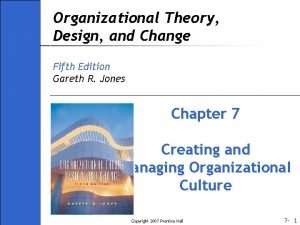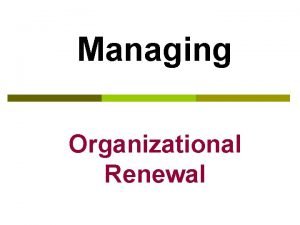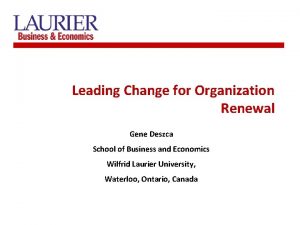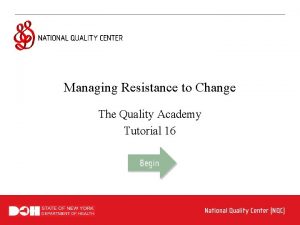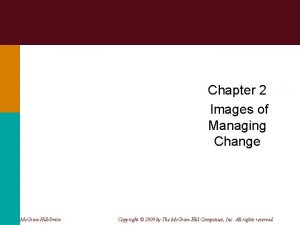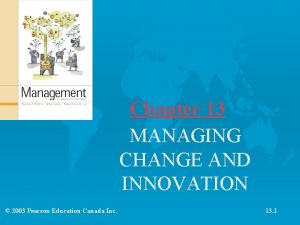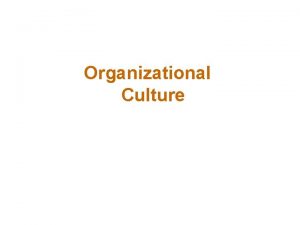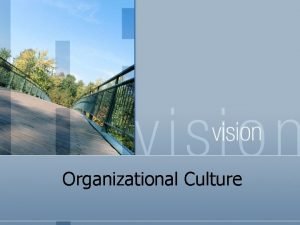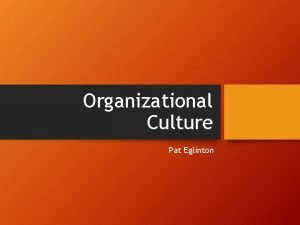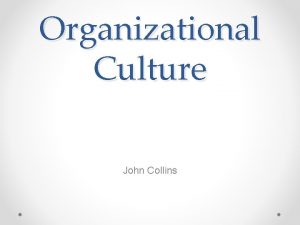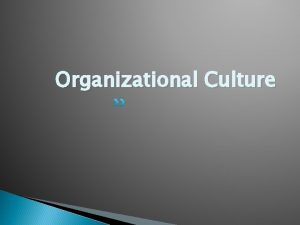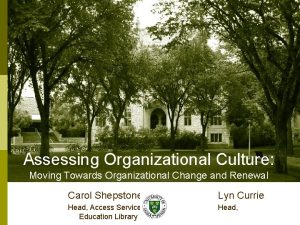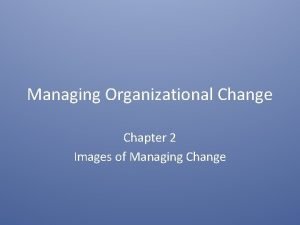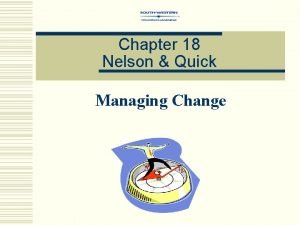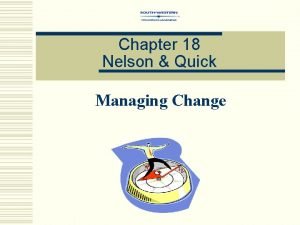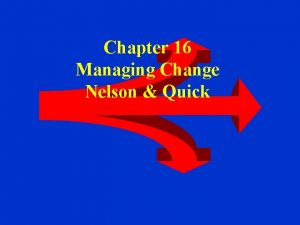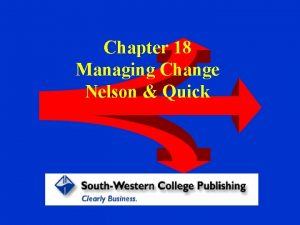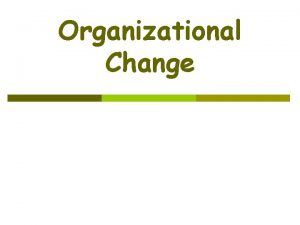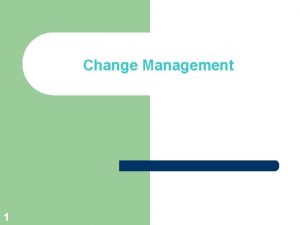Chapter 4 Managing Organizational Culture and Change Mc

























- Slides: 25

Chapter 4 Managing Organizational Culture and Change Mc. Graw-Hill/Irwin Copyright © 2008 by The Mc. Graw-Hill Companies, Inc. All rights reserved

Learning Objectives Slide 2 After reading this chapter, you should be able to: • Identify the three major aspects of organizational culture. • Apply a simple assessment tool to quickly gain a sense of the culture of an organization. • Describe the importance of organizational culture. • Identify the processes through which organizational culture can be developed and sustained. • Use classification systems to identify various types of organizational culture. • Identify the sources of resistance to change. • Apply models to effectively manage change efforts. Mc. Graw-Hill/Irwin Copyright © 2008 by The Mc. Graw-Hill Companies, Inc. All rights reserved

Slide 3 Organizational Culture • A system of shared values, assumptions, beliefs, and norms that unite the members of an organization. • Reflects employees’ views about “the way things are done around here. ” • The culture specific to each firm affects how employees feel and act and the type of employee hired and retained by the company. Mc. Graw-Hill/Irwin Copyright © 2008 by The Mc. Graw-Hill Companies, Inc. All rights reserved

Levels of Corporate Culture Slide 4 Visible Culture Expressed Values Core Values Mc. Graw-Hill/Irwin Copyright © 2008 by The Mc. Graw-Hill Companies, Inc. All rights reserved

Key Effects of Organizational Culture Slide 5 Employee Self-management Organizational Culture Stability Socialization Strategy Implementation Mc. Graw-Hill/Irwin Copyright © 2008 by The Mc. Graw-Hill Companies, Inc. All rights reserved

Key Effects of Organizational Culture Slide 6 • Employee Self-Management ØSense of shared identity ØFacilitates commitment • Stability ØSense of continuity ØSatisfies need for predictability, security, and comfort Mc. Graw-Hill/Irwin Copyright © 2008 by The Mc. Graw-Hill Companies, Inc. All rights reserved

Slide 7 Key Effects of Organizational Culture • Socialization ØInternalizing or taking organizational values as one’s own • Implementation Support of the Organization’s Strategy ØIf strategy and culture reinforce each other, employees find it natural to be committed to the strategy Mc. Graw-Hill/Irwin Copyright © 2008 by The Mc. Graw-Hill Companies, Inc. All rights reserved

Stages of the Socialization Process Slide 8 Pre-arrival Encounter Metamorphosis Mc. Graw-Hill/Irwin Copyright © 2008 by The Mc. Graw-Hill Companies, Inc. All rights reserved

Slide 9 Managing Cultural Processes Cultural Symbols Company Rituals and Ceremonies Company Heroes Stories Organizational Policies and Decision Making Mc. Graw-Hill/Irwin Language Leadership Copyright © 2008 by The Mc. Graw-Hill Companies, Inc. All rights reserved

Slide 10 Characteristics and Types of Organizational Culture • Cultural Uniformity versus Heterogeneity • Strong versus Weak Cultures • Culture versus Formalization • National versus Organizational Culture Mc. Graw-Hill/Irwin Copyright © 2008 by The Mc. Graw-Hill Companies, Inc. All rights reserved

Slide 11 Characteristics and Types of Organizational Culture (continued) • Types: Traditional Control or Employee Involvement ØTraditional control üemphasizes the chain of command ürelies on top-down control and orders ØEmployee involvement üemphasizes participation and involvement Mc. Graw-Hill/Irwin Copyright © 2008 by The Mc. Graw-Hill Companies, Inc. All rights reserved

Four Types of Culture Classification Slide 12 – Baseball team culture--rapidly changing environment – Club culture--seeks loyal, committed people – Academy culture--hires experts who are willing to make a slow steady climb up a ladder – Fortress culture--focused on surviving and reversing sagging fortunes Mc. Graw-Hill/Irwin Copyright © 2008 by The Mc. Graw-Hill Companies, Inc. All rights reserved

Competing Values Framework Slide 13 • Based on two dimensions: focus and control Ø Focus--whether the primary attention of the organization is directed toward internal dynamics or directed outward toward the external environment ØControl--the extent to which the organization is flexible or fixed in how it coordinates and controls activities Mc. Graw-Hill/Irwin Copyright © 2008 by The Mc. Graw-Hill Companies, Inc. All rights reserved

Competing Values Framework Internal Focus Slide 14 External Flexible Control Fixed Mc. Graw-Hill/Irwin Copyright © 2008 by The Mc. Graw-Hill Companies, Inc. All rights reserved

Types of Change Slide 15 • Planned Change--change that is anticipated and allows for advanced preparation • Dynamic Change--change that is ongoing or happens so quickly that the impact on the organization cannot be anticipated and specific preparations cannot be made Mc. Graw-Hill/Irwin Copyright © 2008 by The Mc. Graw-Hill Companies, Inc. All rights reserved

Forces for Change: Environmental Forces Slide 16 • Put pressure on a firm’s relationships with customers, suppliers, and employees. • Environmental forces include: ØTechnology ØMarket forces ØPolitical and regulatory agencies and laws ØSocial trends Mc. Graw-Hill/Irwin Copyright © 2008 by The Mc. Graw-Hill Companies, Inc. All rights reserved

Forces for Change: Internal Forces Slide 17 • Arise from events within the company. • May originate with top executives and managers and travel in a top-down direction. • May originate with front-line employees or labor unions and travel in a bottom-up direction. Mc. Graw-Hill/Irwin Copyright © 2008 by The Mc. Graw-Hill Companies, Inc. All rights reserved

Slide 18 Resistance to Change Self-Interest Cultures that Value Tradition Different Perspectives and Goals Mc. Graw-Hill/Irwin Lack of Trust and Understanding Uncertainty Copyright © 2008 by The Mc. Graw-Hill Companies, Inc. All rights reserved

Models of Organizational Change: The Star Model Slide 19 • The Star Model: Five Points ØTypes of changeevolutionary or transformational ØStructure ØReward system ØProcesses ØPeople Mc. Graw-Hill/Irwin Copyright © 2008 by The Mc. Graw-Hill Companies, Inc. All rights reserved

Slide 20 Lewin’s Three-Step Model of Organizational Change • Unfreezing--melting away resistance • Change--departure from the status quo • Refreezing--change becomes routine Mc. Graw-Hill/Irwin Copyright © 2008 by The Mc. Graw-Hill Companies, Inc. All rights reserved

Slide 21 Lewin’s Force Field Analysis Model • Increase driving forces that drive change • Reduce restraining forces that resist change • or do both Mc. Graw-Hill/Irwin Copyright © 2008 by The Mc. Graw-Hill Companies, Inc. All rights reserved

Slide 22 Force-field Model of Change Desired state Restraining forces Status quo Driving forces Time Mc. Graw-Hill/Irwin Copyright © 2008 by The Mc. Graw-Hill Companies, Inc. All rights reserved

Implementing Organizational Change Slide 23 Top-down Change Agents Bottom-up Change Mc. Graw-Hill/Irwin Copyright © 2008 by The Mc. Graw-Hill Companies, Inc. All rights reserved

Slide 24 Four Types of Employees Performance Low High Mc. Graw-Hill/Irwin Alignment with culture No Yes Worst Give Another Chance Make the tough choice Best Copyright © 2008 by The Mc. Graw-Hill Companies, Inc. All rights reserved

Tactics for Introducing Change Communication and Education Slide 25 Employee Involvement Negotiation Coercion Top-Management Support Mc. Graw-Hill/Irwin Copyright © 2008 by The Mc. Graw-Hill Companies, Inc. All rights reserved
 Managing change and innovation
Managing change and innovation White-water rapids metaphor
White-water rapids metaphor Chapter 18 organizational change and stress management
Chapter 18 organizational change and stress management Chapter 16 organizational culture
Chapter 16 organizational culture Customer responsive culture
Customer responsive culture Mengelola perubahan dan inovasi
Mengelola perubahan dan inovasi Organizational design: structure, culture, and control
Organizational design: structure, culture, and control Organizational culture and ethical decision making
Organizational culture and ethical decision making Material and non material culture examples
Material and non material culture examples Continuous culture and batch culture
Continuous culture and batch culture Indian culture vs american culture
Indian culture vs american culture Stab culture and stroke culture
Stab culture and stroke culture Folk culture and popular culture venn diagram
Folk culture and popular culture venn diagram What is folk culture
What is folk culture Stab culture and stroke culture
Stab culture and stroke culture Folk culture and popular culture venn diagram
Folk culture and popular culture venn diagram Stroke culture method
Stroke culture method Lawn or carpet culture
Lawn or carpet culture Surface culture deep culture and esol
Surface culture deep culture and esol Organizational theory design and change
Organizational theory design and change Leading change and organizational renewal
Leading change and organizational renewal Leading change and organizational renewal
Leading change and organizational renewal Organizational theory design and change
Organizational theory design and change Managing complex change
Managing complex change Image of change management
Image of change management Contemporary issues in managing change
Contemporary issues in managing change
